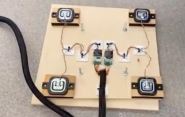New Tools to Precisely Measure a Cardiac Patient's Recovery

Once again, the students of Engineering Innovation & Design (ENAS 118) have produced a number of innovations while working their clients - the people who encounter these issues regularly and simply want a better way to tackle them. Taught by SEAS senior research scientist Larry Wilen and SEAS Deputy Dean Vince Wilczynski, most of the work took place in the John Klingenstein '50 Design Lab at the Center for Engineering Innovation & Design (CEID), although some students worked remotely from various locations around the globe. Today, we feature two medical-related projects.
Recovery from cardiac surgery can be an arduous process for patients, and for doctors, a tricky one. That’s partly because certain milestones are difficult to measure precisely. Two student teams in ENAS 118 took on the challenge of making it easier for health care workers to know when their patients are ready to move to the next step of their recovery.
Both teams worked with their clients Dr. Basmah Safdar, director of the Yale New Haven Hospital Chest Pain Center, Dr. Abeel Manji, an attending surgeon in the Section of Cardiac Surgery at Yale University, and Thomas Newman, Yale's director of student-athlete innovation & performance.
 The students behind Team Rehab/Standing - Melissa Adams '24, Luna Aguilar '24, and Lily Dorstewitz '24 - developed a way to measure a patient’s ability to stand after cardiac surgery. The ability to stand is one of the milestones doctors look for on deciding when to move on to the phase of recovery. But the variables involved make it a difficult thing to quantify.
The students behind Team Rehab/Standing - Melissa Adams '24, Luna Aguilar '24, and Lily Dorstewitz '24 - developed a way to measure a patient’s ability to stand after cardiac surgery. The ability to stand is one of the milestones doctors look for on deciding when to move on to the phase of recovery. But the variables involved make it a difficult thing to quantify.
The students developed a device in which patients pull on a bar equipped with two load cells that measure the force exerted. A box with a liquid crystal display shows whether the patient is exceeding a set threshold of force. The goal is for the patient to meet or exceed the threshold for 5 seconds.
Dr. Safdar said the device is “a really creative way to assess functional movement,” noting that current methods of assessing the ability to stand are limited.
“So we came up with a project on how to assess functional movement - the ability to stand, ability to squat, ability to pick up something from the ground - and this is a really great way of assessing one of them,” she said. “I also like the fact that it's user-friendly. I think it makes it really intuitive for patients who have to focus on so many other things.”
 For the project, “Step Up,” Jenny Mao '24, Kalina Mladenova '24, and Justin Lai '24, devised a way to quantify a patient’s ability to climb stairs after cardiac surgery. Another milestone in recovery, assessing a patient’s stair-climbing is also imprecise and reliant on observations. With Step Up, the students created a device that provides a data-driven means of assessing that ability.
For the project, “Step Up,” Jenny Mao '24, Kalina Mladenova '24, and Justin Lai '24, devised a way to quantify a patient’s ability to climb stairs after cardiac surgery. Another milestone in recovery, assessing a patient’s stair-climbing is also imprecise and reliant on observations. With Step Up, the students created a device that provides a data-driven means of assessing that ability.
The device works much like a scale, with four load cells that measure the weight exerted at the front and back parts of the foot. Using these readings, health care workers can calculate the patient’s center of mass and whether it meets or exceeds a set threshold. If it’s within the designated range, the rectangle on the display turns green. And if the center of mass moves too far forward or backward, suggesting that the patient is off-balance, then the rectangle turns red.
“What I love about it is that you’re addressing something that's most difficult for us to measure, which is balance, and something especially problematic for older individuals,” Safdar said. “The fact that you can generate all this data for us to track would allow us to see the feasibility and implementability of the tool. It's very exciting and something that we could probably incorporate in a trial that we're actually just starting.”

